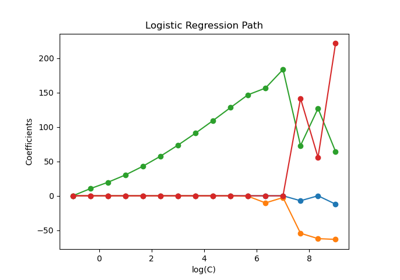l1_min_c#
- sklearn.svm.l1_min_c(X, y, *, loss='squared_hinge', fit_intercept=True, intercept_scaling=1.0)[source]#
Return the lowest bound for C.
The lower bound for C is computed such that for C in (l1_min_C, infinity) the model is guaranteed not to be empty. This applies to l1 penalized classifiers, such as LinearSVC with penalty=’l1’ and linear_model.LogisticRegression with penalty=’l1’.
This value is valid if class_weight parameter in fit() is not set.
- Parameters:
- X{array-like, sparse matrix} of shape (n_samples, n_features)
Training vector, where
n_samplesis the number of samples andn_featuresis the number of features.- yarray-like of shape (n_samples,)
Target vector relative to X.
- loss{‘squared_hinge’, ‘log’}, default=’squared_hinge’
Specifies the loss function. With ‘squared_hinge’ it is the squared hinge loss (a.k.a. L2 loss). With ‘log’ it is the loss of logistic regression models.
- fit_interceptbool, default=True
Specifies if the intercept should be fitted by the model. It must match the fit() method parameter.
- intercept_scalingfloat, default=1.0
When fit_intercept is True, instance vector x becomes [x, intercept_scaling], i.e. a “synthetic” feature with constant value equals to intercept_scaling is appended to the instance vector. It must match the fit() method parameter.
- Returns:
- l1_min_cfloat
Minimum value for C.
Examples
>>> from sklearn.svm import l1_min_c >>> from sklearn.datasets import make_classification >>> X, y = make_classification(n_samples=100, n_features=20, random_state=42) >>> print(f"{l1_min_c(X, y, loss='squared_hinge', fit_intercept=True):.4f}") 0.0044

